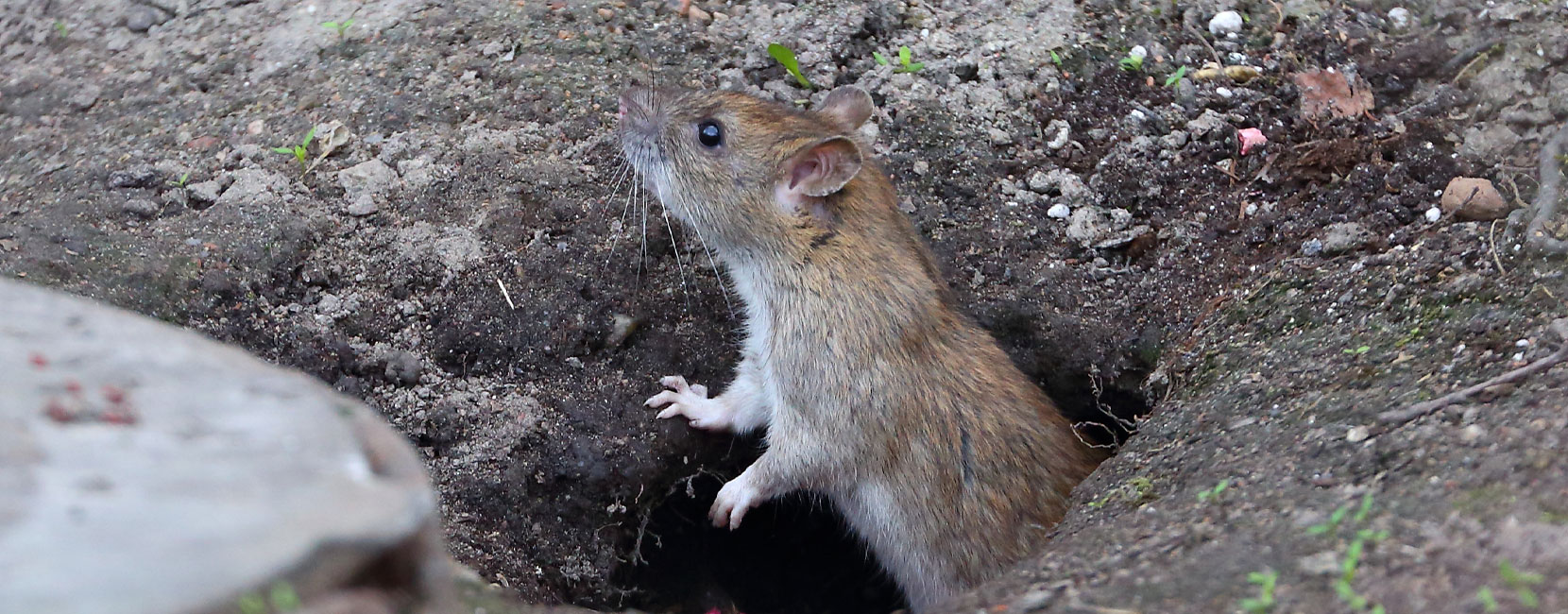
How to Get Rid of Subterranean Termites
There are approximately 45 species of termites found in the United States. Depending upon their distinct characteristics, they are classified as subterranean termites, drywood termites, or dampwood termites. As suggested by their name, subterranean termites live under the ground in large colonies. Drywood termites do not require the moisture provided by the earth and live exclusively in the piece of wood they are infested. Dampwood termites usually do not nest in the ground, but the wood that they infest must be quite wet. Because of these unique characteristics, each kind of termites are treated differently. This article will primarily focus on subterranean termites; for information on drywood termites, please read our guide on drywood termites.
It is estimated that termites cause $40 billion dollars in damage worldwide every year. Subterranean termites cause about 80% of this damage. Subterranean colonies can grow very large and formidable when permitted to grow unobstructed. Your home, along with other structures on your property, such as the shed or the barn, is probably your most valuable asset. In termite infested areas, protecting your home requires vigilance, and often the help of a trained Pest Management Professional.
Subterranean Termite Identification

Often, you become aware of termites in or near your home when the reproductives fly from the colony in an attempt to establish a new colony. Thousands of dead winged insects may lay scattered on your porch, near the door framing, or the windowsill. Most every homeowner knows a risk of termites exists, but this phenomenon of swarming insects brings visions of expensive treatments and extensive damage to your home. However, the insects may not be termites after all. Before you assume the worst-case scenario, take a few minutes and determine if you are looking at a swarm of winged ants or a swarm of winged termites. You can quickly ascertain the threat level by closely examining the wings, antennae, and body shape on the insects.
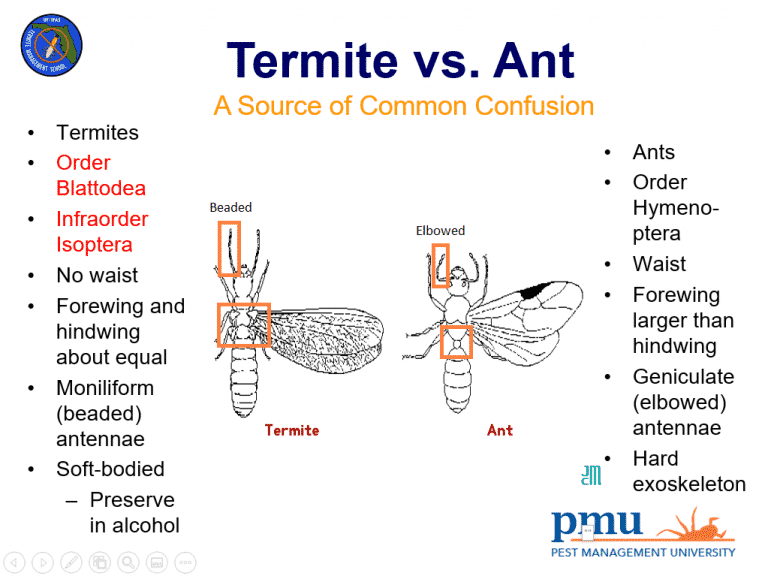
- Waist
- Ant – skinny waist (a narrow area between the thorax and first abdominal segment).
- Termite – no skinny waist, thorax and abdomen are broadly connected.
- Wings
- Ant – Front pair of wings is larger than the hind pair; few veins and usually clear in color.
- Termite – The four wings are approximately the same size and shape; veins may be clear, milky, or dark in color.
- Antennae
- Ant – Antennae are elbowed.
- Termite – Antennae are straight.
Subterranean Termite Species
Whether your specimen be ants or termites, it is helpful to save a few of the insects before you vacuum or sweep up evidence of the swarm. Many states have insect identification laboratories, and many county extension offices have extension agents that can identify your specimen as well. It is important to properly package the specimen so that it is not damaged and rendered useless for identification purposes while in transit. Place insects you wish to have examined in a small tightly sealed container with isopropyl alcohol. If you can provide soldiers or winged reproductives, that is more helpful than the more plentiful termite workers. Many labs have questionnaires where you can give additional information such as where the specimen was found, the date of collection, and any other information that may be relevant.
Subterranean termites are found throughout the United States, but are mostly concentrated in warm southern states. The warm humid areas between Florida and Southern California are prime real estate for subterranean termites. However, the desert subterranean termite thrives in the deserts of Arizona and Southeast California. Your particular region of the country may experience localized infestations of a species of termite. A local experienced Pest Management Professional will know of infestations in your area. If an insect specimen is determined to be a subterranean termite, it is most likely an eastern or western subterranean termite, but the geographic range of the formosan termite is quickly expanding.
Eastern Subterranean Termite
Reticulitermes flavipes (Kollar)
- Geographic Range – Spans from the Florida Keys to Ontario, Canada along the eastern region of North America.
- Colony Size – Colonies of between 60,000 individuals to nearly one million termites.
- Size and Color
- Workers – cream colored, about 1/8” in length
- Soldiers – cream colored body with orange rectangular head, large dark mandibles which are used to defend the colony
- Alates (Reproductives) – dark brown, about 0.4” including the wings
- Key Characteristics – Alates wings are brownish grey with two dark solid veins along the forefront of the front wings. The front wing is larger than hind wing.
Western Subterranean Termite
Reticulitermes hesperus (Banks)
- Geographic Range – Spans from British Columbia to Western Mexico, along the western region of the United States.
- Colony Size – Colonies of between 60,000 individuals to nearly one million termites.
- Size and Color
- Workers – 0.18 inches in length, creamy colored
- Soldiers – Similar body to the workers, but with an orange rectangular shaped head, with large pincher like mouthparts that are used to defend the colony.
- Alates (Reproductives) – 3/8” including wings, dark brown body with brownish-grey wings
- Key Characteristics – usually swarm in the spring after a rain; damage is most commonly found in basements
Formosan Subterranean Termite
Coptotermes formosanus (Shiraki)
- Geographic Range – Originally from Taiwan or China, Formosan termites are now found in Japan, Hawaii, South Africa, and southern states including, Florida, Texas, Louisiana, Alabama, Georgia, Mississippi, Tennessee, and North and South Carolina.
- Colony Size – Very large colonies, may contain colonies with several million termites who forage up to 300 feet.
- Size and Color
- Workers – white or off-white, difficult to distinguish from other subterranean termites
- Soldiers – orangish brown oval shaped head with curved mandibles, white body. When threatened, they release a white substance from their head.
- Alates (Reproductives) – yellowish brown, approximately 0.5” in length, numerous small hairs on their wings.
- Key Characteristics – extraordinarily large colonies; they often build aerial nests.
These termites notoriously infest trees (Figures 32, 33). If you find these termites in trees, call an experienced pest control company to treat them. You may see the pest control company foam the voids with a registered termiticide or place baits at the base of the tree. Soil drenches with systemic insecticides labeled for applications may also be used.


Subterranean Termite Damage
Subterranean termites cause much more damage than drywood or dampwood termites. Subterranean termites live in larger colonies and because their nests are often underground, they remain out of sight for years. Often, termite damage is not covered by your homeowner’s insurance policy, so any damage is yours to contend with.
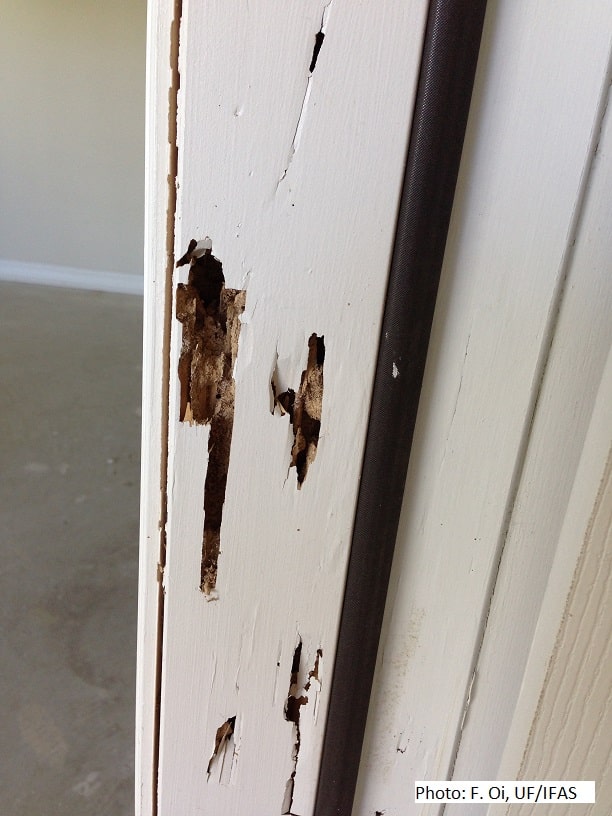
If these termites remain undetected year and after year, the damage potential increases as the colonies grow and mature. A formosan subterranean termite colony may be 100x the size of other subterranean termite colonies; because of the sheer number of individuals they can do 100x this amount of damage per year!
Termites have the unique ability to digest cellulose. Cellulose is found in wood and paper. In their pursuit of cellulose, termites can damage other materials in your home. Although they do not eat it for nutrition, they can tunnel through spray foam to reach a food source. A thick layer of spray foam in your attic or crawlspace makes a proper termite inspection nearly impossible. Termites will consume the paper layer found on some insulations and tunnel through the insulation itself lessening its insulating properties.

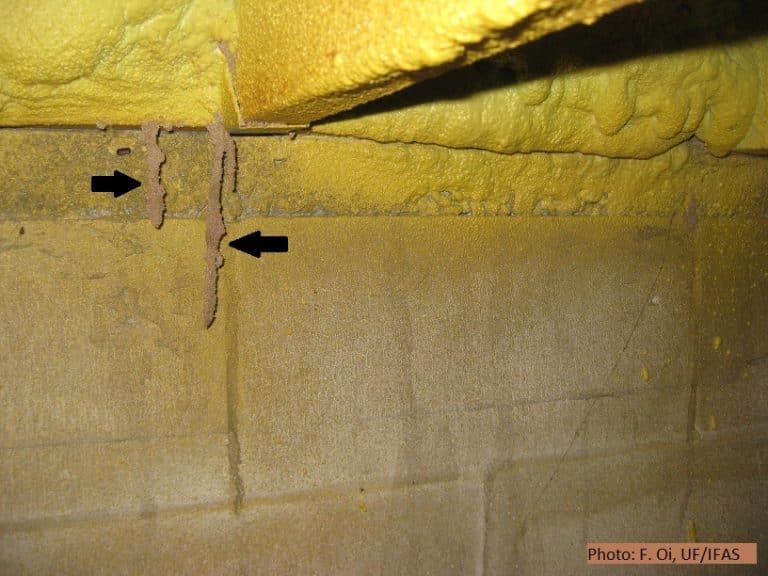
Subterranean termite damage is distinctive. A trained and experienced Pest Management Professional can usually look at a piece of damaged wood and identify if it was damaged by subterranean or drywood termites. Subterranean termites use their saw-toothed jaws to chew wood one piece at a time. They follow the grain of the wood and only eat the softer springwood growth of the wood. Therefore, the damage from subterranean termites will follow the pattern of the wood, but they often leave the outer layer of the wood intact. Subterranean termites eat the wood from the inside out, so most of the damage is hidden from plain view. Often a probing tool, such as a screwdriver, helps to locate subterranean termite damage. When tapped on, wood damaged by termites sounds hollow.
When subterranean damage is located and an active infestation is identified, treatment should be applied as quickly as practicable. There is no need to make any rash overnight decisions, but get several estimates and select a pest management company to treat as soon as possible to prevent additional damage.
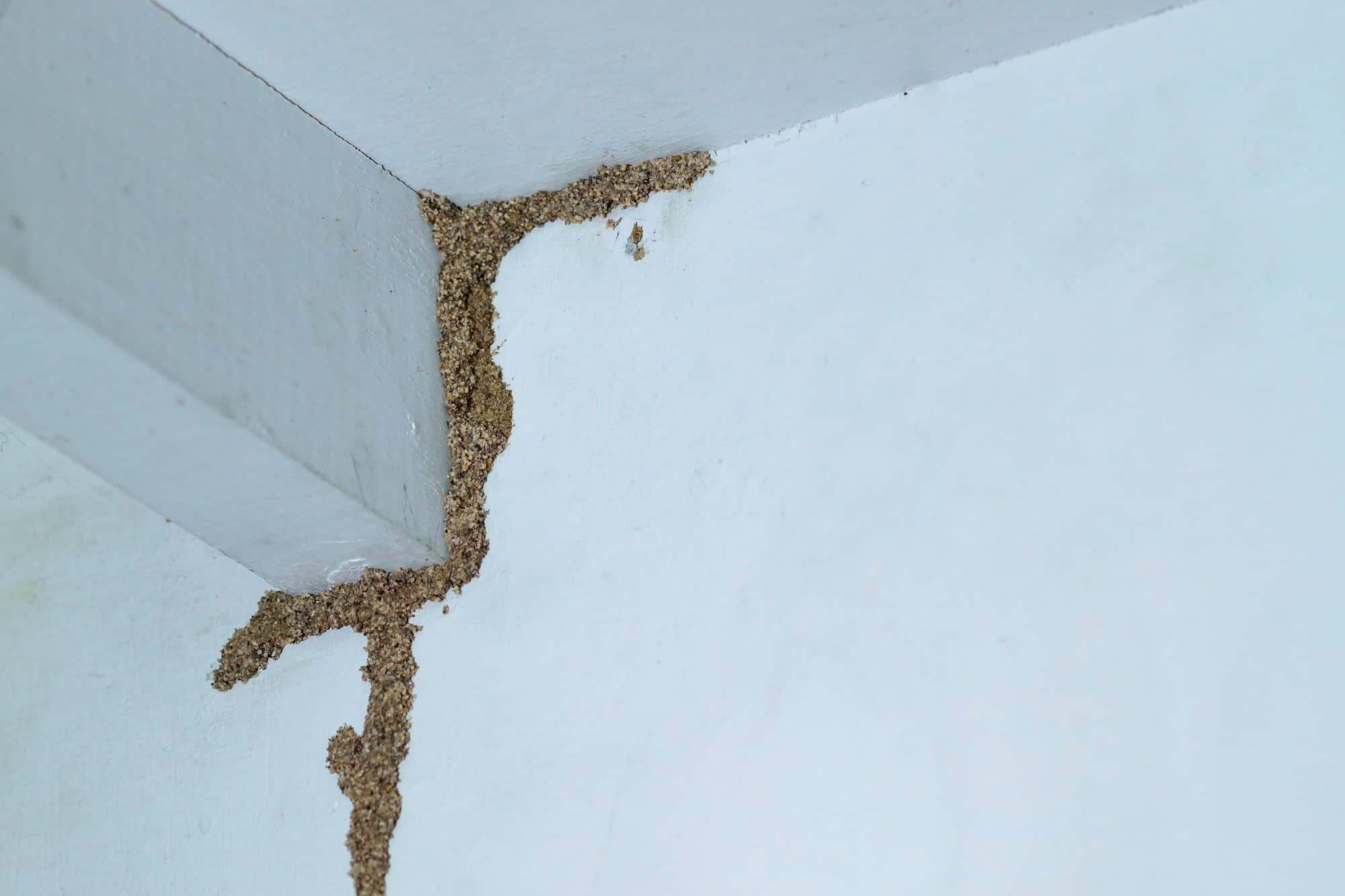
Subterranean Termite Mud Tubes
A tell-tail sign of drywood termites is the presence of termite pellets or fecal matter appearing on a windowsill or countertop. With subterranean termites you will not see the coffee grind looking pellets because they utilize their waste to create mud tubes. Subterranean termite colonies are usually located in the ground. However, the workers, who forage for wood/food, are at risk of drying out and predation as they seek new food sources. To connect the nest to the source of food, termites build protective tunnels with their feces, saliva, and dirt. These mud tubes are often found at the foundation of a building and allow termites to safely travel long distances. They may also be found around sills, sub floors, joists, under porches, and around window frames.
Termites have the ability to construct different types of mud tubes for different purposes. Exploratory mud tubes are thin and fragile and branch off in many directions. These are used when termites are exploring for new food sources. Working mud tubes, or utility tubes, are built stronger and more durable. Working mud tubes act as a highway transporting termites and food to the food source and back to the nest. Swarm castles, or swarm tubes are built as the colony prepares to swarm. These shelters keep the swarmers organized and protected as they embark upon their flight. Drop tubes look like stalagmites in a cave. These are tubes that are suspended from the ground directly to the wood source. Although most mud tubes are fairly small, some mud tubes have been observed to extend 50-60 feet.
To an unsuspecting homeowner, a mud tube may appear to be mud splatter or just dirt around the foundation of your home. However, upon closer inspection, you will notice the efficient engineering and design of these mud tubes. The presence of mud tubes on your home indicates either a past or present termite infestation. Perhaps termites explored in the area, could not find an entry point and have moved on. If you break open a tube and find termites scurrying through the tunnels, that is a strong indication of an active infestation. If you break open a mud tube and do not find termites inside, check it again in about a week. If it is repaired, you definitely have termites in the area and you should consult a Pest Management Professional.
Social Structure of Termite Colonies
Subterranean termites are social insects that live together underground in large colonies. They form large, interconnected nests underground and send workers to forage for food. The common species of subterranean termites in the continental United States, may contain about one million termites and their workers forage up to 150 feet from the nest. Formosan subterranean termites may be several million termites strong and forage up to 300 feet from the nest. When subterranean termites forage for food, they may enter a home through small cracks or joints in the foundation, or by building a mud tube along the foundation. Once a reliable source of wood is located, termites do not usually leave on their own.
Termites are born into a distinct caste, and they dutifully carry out their assigned tasks. The termites in the colony work to cooperatively care for the young and share resources such as food and shelter. A new subterranean termite colony begins when winged reproductives fly from their nest, mate, and locate a suitable nesting spot. These become the queen and king of the new colony. The king and queen live in a central chamber and are tended to by the workers. A subterranean termite queen can live up to 25 years with peak egg production for about 10 years. Subterranean colonies generally take about 3 years to be strong and large enough to swarm.
Subterranean Termite Workers

Credit: James Castner, University of Florida
Workers are the most common caste of termite in the colony, constituting over 90% of the termites in the colony. Termite workers do not have wings and are a creamy white color. The workers forage and bring food back to the underground colony; therefore, it is the workers that cause damage to our homes and structures. Workers are also responsible for creating and enlarging the nest, hollowing tunnels within the nest, grooming and feeding all the other termites in the colony, and caring for the young.
Termite workers have the unique ability to process the cellulose in the wood they consume into a usable form of food. Their guts have bacteria, protozoa, and enzymes which convert the cellulose in the wood to a sugary substance. The workers then feed the queen and king, the soldiers, and the immature termites via mouth to mouth. This process called trophallaxis is important when thinking about termite treatments, because some termite treatments exploit this characteristic.
Subterranean Termite Soldiers

Subterranean termite soldiers have darkened heads and large pincer like jaws. Their primary job is to defend the nest from enemies, primarily ants. Soldiers make up 5-10% of the termite colony. If you break open an active mud tube, you will likely see soldiers rush out to defend the attack. With their large heads, soldiers will sometimes plug a hole in a damaged mud tube as well. To warn of danger, soldiers will sometimes bang their head against the mud tube causing vibrations. If you are lucky enough to watch an active swarm, you will notice soldiers at the exit hole as the swarmers leave the nest. This is the last vestige of protection that the colony will afford these swarmers.
Subterranean Termites with Wings

Credit: James Castner, University of Florida
Swarmers, or reproductives are the subterranean termites that have wings. Once a colony is mature and strong enough, the queen will begin to produce alates, or termites capable of reproduction. Swarmers are only produced during specific times of the year, and fly out of the nest with the hopes of reproducing and starting a new colony. Depending upon the species and the geographic location, termite swarms are fairly predictable. Depending upon your area, Pest Management Professionals refer to “swarm season” as one of their busiest times of the year.
Most of the alates that fly from the nest will not be successful in starting a new colony. They may dry out and die, they may be eaten by birds or ants, or they may not find a mate. When the alates fly from the colony the female emits a mating pheromone. If the male finds her and mates with her, they break off their wings, and attempt to find a suitable place to build a home for their brood. These swarmers are often attracted to lights. Homeowners often wake to find a graveyard of termite wings on windowsills, densely covering nearby spiderwebs, and on the front or back porch. The presence of a termite swarm around your home does not necessarily mean that you actively have termites consuming the wood in your home, but there is definitely a termite colony nearby. Your home may be at risk.
Subterranean Termite Inspection
Upon noticing signs of a termite swarm, mud tubes, or damaged wood in your home, you should contact a Pest Management Professional to conduct a thorough inspection. A quality inspection is the central tenant of Integrated Pest Management. These individuals are trained and experienced in finding termites, identifying conditions where termites might be likely to infest, and determining the extent of termite damage to your home.
A thorough termite inspection often involves crawling through the crawl space or basement, if applicable, and inside the attic. Use a bright flashlight and look for areas of shed wings, mud tubes. Using a screwdriver or ice pick probe and tap on wood. If the wood sounds hollow or the outer layer crumbles, continue to prod until you have identified what caused the damage.
Pay special attention to locations where wood makes contact with the ground. These areas act as an easy access point to other areas of the structure. For example, wood under porches, sills, subfloors, joists, support posts, and basement window frames are common entry points for termites. Vigilantly inspect areas around any cracks in the cement or expansion joints, or cracks in brick work. Termites can easily slip through cracks in concrete and cause extensive damage that is difficult to locate.
Finding warped wood or bubbling paint is cause to further investigate. Termites may be eating it from inside out and you need to tap or probe the wood to find out if it is hollow behind the paint. Most termites prefer soft moist wood.
A termite inspection is limited to areas that are accessible. Termites live underground and the majority of their activity is hidden behind walls and in other inaccessible areas. A thorough termite inspector should look at the totality of the circumstances when making a recommendation. Just because no live termites were found during the inspection, does not mean there are no live termites in your home. Many termite infestations are found during remodel projects, once drywall and fixtures are removed. Insulation in the attic hides termites as does drywall. If anecdotal evidence suggests the presence of termites, consider a termite treatment before the damage is impossible to ignore.
How Can I Prevent Termites
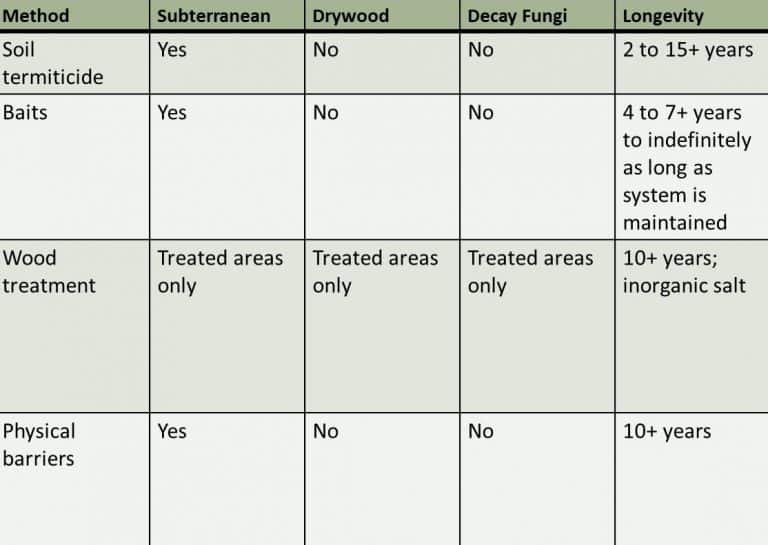
In many areas of high termite activity, such as Florida or Southern California, termites are a reality that most homeowners will have to grapple with at some point. Termites naturally occur in the landscape and aid in the decomposition process by consuming dead trees. They aerate the soil and add nitrogen to soil allowing for increased soil health. The goal of termite pest control is to protect structures, not to eradicate termites from the earth.
By making a few simple changes and implementing good home maintenance practices you dissuade termites from accessing the wood in your home.


- Eliminate wood to ground contact.
- Remove wooden debris such as lumber and branches from your yard.
- Stack firewood away from your home or any structure you wish to protect.
- Keep an inspection space of at least 10” from the bottom of wall siding and soil or mulch. This allows any mud tubes to be visible.
- Ensure that water runs away from the structure, not towards it.
- Direct A/C Drainage lines away from your home.
- Fix water leaks, both interior and exterior.
- Direct irrigation heads away from the structure.
- Do not store items that hold moisture, such as rain barrels or compost bins, within 2 feet of your home.
- Making account for future growth, do not plant landscape hedges within 2 feet of the structure.
- Avoid using wooden landscape timbers.
- Trim trees and branches away from the home. Subterranean termites can use branches to access structures.


What you can do to prevent termites, continued:
- Landscape plants should be placed at least 2 feet away from exterior walls (Figure 14).
- Account for future growth.
- Improper plant placement will create conducive conditions that may void termite warranties (Figure 15a, b).
- Avoid using wooden landscape timbers for edging.



What you can do to prevent termites, continued:
- Keep soffits in good repair and screen vents to help prevent termite swarmers and other pests from entering attics.
- Trim tree and shrub branches away from walls and roofs (Figure 16).
- Branches that touch the roof of a structure can allow subterranean termites to use it as a bridge and access structures (Figure 17).


Termite Inspection Contracts
Consider contracting with a licensed and insured pest control company with experience and certifications in termite control to do an “annual renewal inspection.” Under many of these contracts, an experienced termite inspector will inspect your home on a yearly basis. If after a clear inspection, it becomes known that your home has termites, the company will treat the termites. These contracts are often offered to people after a termite treatment is performed on a structure or when a termite inspection is done to facilitate the sale or purchase of the home.
As with any contract, it is imperative that you read and understand the details of your specific agreement. Specific conditions can invalidate the contract. For example, if you have spray foam placed in the attic, or if your hedges are too close to the structure, you may not be covered under the contract. Many of these contracts only guarantee that there are no termites in areas that are accessible to inspect. So, a termite infestation that is hidden behind drywall may not be covered under this contract. These termite contracts can be a valuable tool, so long as you understand what is covered and what is not. During these inspections, your termite inspector will point out conditions that may allow termites to thrive, allowing you to take an active part in termite prevention.
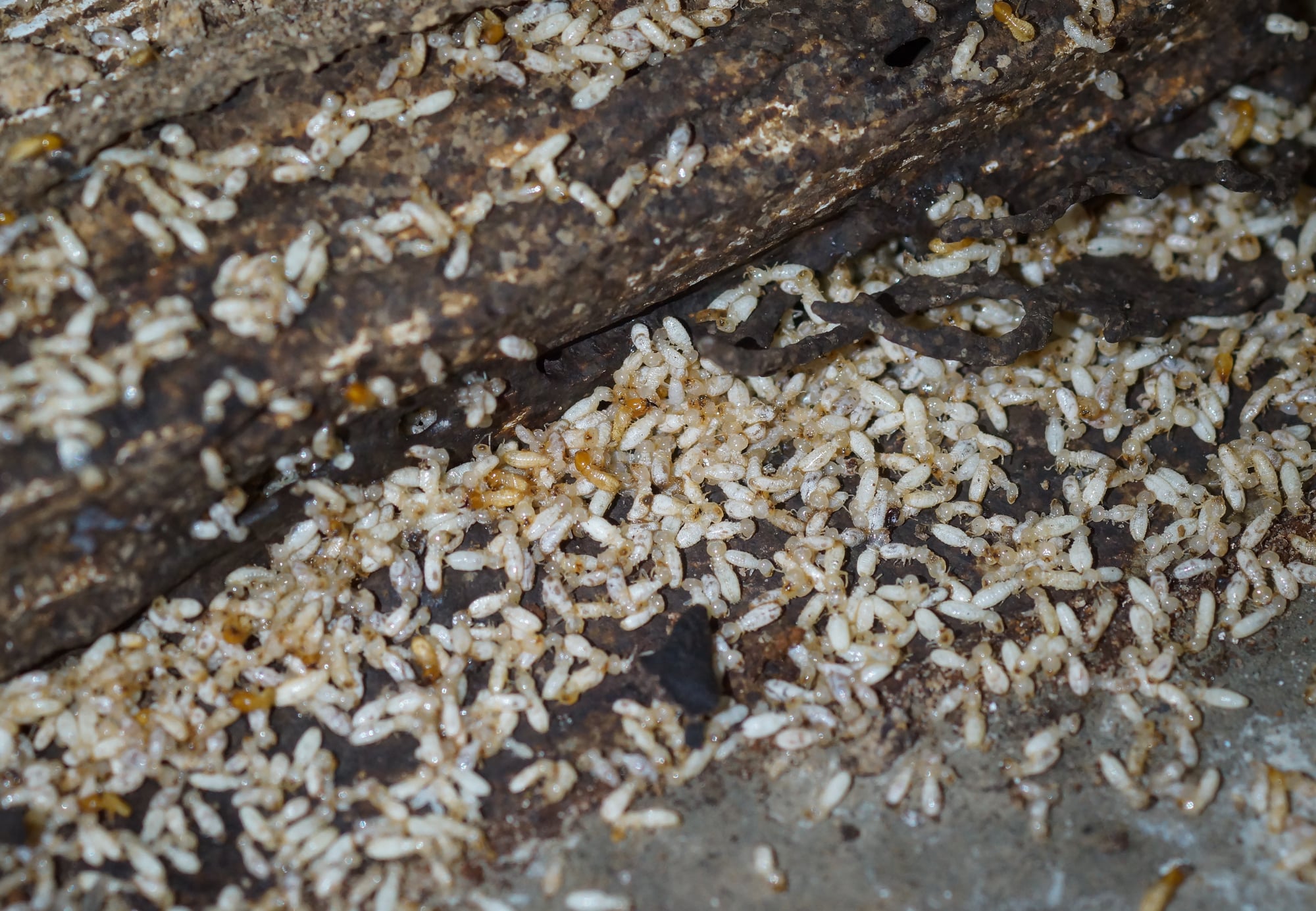
Control Options for Subterranean Termites
When it comes to treatment for subterranean termites there are several very good options. Unlike drywood termites that live exclusively in the wood, these termites are primarily in the ground. Without controlling the termites hidden deep in the underground nest, it is difficult to have long term control of subterranean termites. For this reason, fumigation and spot treatments, which are commonly used for drywood termites, are ineffective as a stand-alone treatment for subterranean termites.
Research shows that in some areas termites are so prevalent that there may be 25 distinct subterranean colonies on one acre of land. Formosan termite colonies can be so large that they cover between an acre to an acre and a half. It is theoretically possible that your home is situated right on top of subterranean termite colonies.
There are two types of subterranean termite treatments. A treatment that occurs before the home or structure is built is called a pre-construction treatment. A termite treatment that occurs after the home is built is called a post-construction treatment. A post-construction treatment may be performed as a soil treatment or with bait. Physical barriers or borate treatments are also available options for dealing with a termite infestation. Every termite infestation is unique; you should rely on the expertise of a termite professional to guide you on the most appropriate termite treatment for your situation.
Pre-Construction Termite Treatment
When building a new home or structure, many states require that prior to pouring the concrete slab, a layer of termiticide be placed in the soil under the foundation. This layer of termiticide prevents termites from tunneling underneath your home and entering through cracks in the foundation. This application must be coordinated between the pest control operator, the contractor, and other subcontractors. Many contractors view this pre-treatment as a perfunctory box that must be checked in order to get on with the business of building the home. However, we view this as an opportunity to add lasting value and termite protection to your home. Many pest control companies offer great quality treatments but others offer low-cost pre-treatment services, using sub-par termiticides. Often, builders will select the lowest price option. We suggest being involved in this process and helping select a reputable pest management company and what type of treatment they provide. Take this opportunity to place a product with the highest efficacy rate possible under your home to protect it for many years to come.
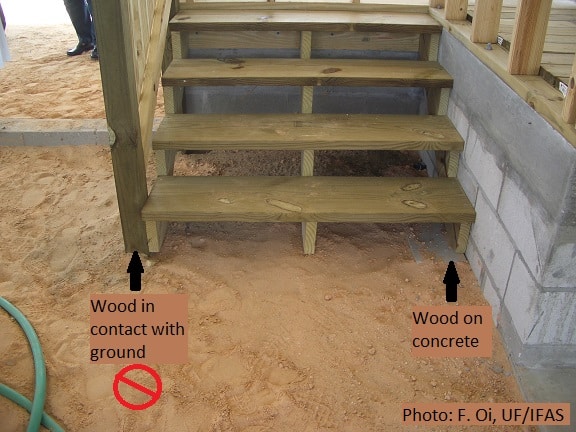
Wood Preventative Treatment/ Borate
Borate wood preventative treatments are usually performed during the construction phase. Disodium octaborate tetrahydrate (DOT) is a common active ingredient used in borate products to protect wood from termites and wood-decay fungi. A borate treatment protects wood that termites manage to access despite other preventative actions. Once the wood framing is installed in a new home, but before it is covered with drywall, a Pest Management Professional will apply the borate to the wood. In the future, should a termite access the wood sprayed with borate, it will be unable to garner nutrients from it and the termite starves to death. While borates are a great tool for certain situations, there is research that shows they are not effective as a preventative treatment for formosan subterranean termites. This should not be used as a stand-alone treatment in states where formosan termites are common.
The pest management professional may opt to include a dye marker because the borate solution is clear. The label requires that the wooden members be treated to a minimum height of two feet.

One of the challenges of a borate treatment is that framing and other wooden elements can be moved or added during the construction process and after the pest management professional is called. Unless the builder calls the pest management professional back to treat the modifications, neither the home buyer nor pest management professional will know that some portions of the structure are not treated.

Soil Termiticide Perimeter Treatment
Once a home is built and it is infested with termites, we move to post-construction treatment options. The tried-and-true termite treatment is a soil treatment placed around the perimeter of the structure. In this treatment, a trench is dug around the foundation of the structure. Then, a termiticide is applied into the trench. Using their knowledge of building construction, soil type, and the EPA approved product label, the applicator will place the correct amount of product at the correct concentration into the trench. In order to protect all areas of the structure, sometimes holes must be drilled into concrete or patio pavers.
Trench around the perimeter of your home in preparation to treat around your home.

They may also drill the slab foundation to get the termiticide to areas that would otherwise be inaccessible.


Treating the trench and drill holes.

Liquid termiticides fall into two categories, repellent and non-repellent. Repellent termiticides are ones that termites can smell and tend to avoid. Examples of repellent termiticides contain bifenthrin (Bifen I/T®, Talstar®) and permethrin (Dragnet™ SFR). Non-repellent termiticides are products that if applied in correct concentrations, the termites can not smell it. Thus, they do not avoid the insecticide. Examples of products that are “non-repellent” contain fipronil (Termidor®, Taurus®), imidacloprid (Premise®, Dominion®), and chlorantraniliprole (Atriset®).
The performance of soil termiticides vary based upon environmental conditions and soil type. If the barrier is disturbed by a flooding from a hurricane or a wildlife digging in the area, another treatment may be necessary to ensure full protection.
Some “non-repellent” termiticides are slow acting and boast a transfer effect. Recall that the workers travel back to the nest and feed and groom the other termites in the colony. Once they have unknowingly travelled through the insecticide, they will transfer it to other termites that do not leave the nest. In this way, the entire colony may be eliminated.
Baits and Monitoring Stations for Subterranean Termites
Baits have been approved for use against termites since the mid-1990s. The two most common termite baits are Sentricon®, which contains the active ingredient novaflumuron and Trelona®, which contains the active ingredient novaluron. Baiting is considered a more “environmentally friendly” approach to eliminating termites as it targets actively foraging termites rather than the blanket approach of a soil treatment. In addition, the active ingredients in termite baits are classified as IGRs, or Insect Growth Regulators. These IGRs are delivered in a way specific to subterranean termites. Some states now allow a termite baiting system to be installed as an acceptable pre-construction treatment.
Termite baits work by placing bait stations around the perimeter of your home. These stations are placed at regular intervals and contain a cartridge with cellulose based substance and the active ingredient or bait. Because subterranean termites are always foraging, if they are poking around your home, they will find the bait station. As they begin to consume the bait, they bring the bait back to the nest. These baits act slowly upon the termites’ system giving them time to feed and groom the other termites in the colony. Ultimately, the termite colony, including the queen will perish.
What you may see your pest management professional do:


Termite baiting is an active process, and the bait stations should be checked regularly for activity and freshness. If termites are actively consuming the bait from a station, ensure it does not run out. Even large colonies of Formosan termites have been eradicated using termite baits.
Non-Chemical Treatment for Subterranean Termites / Physical Barrier
There are several types of physical barriers that may prevent termites from accessing the wood in your home. Many of these systems are not widely used in the United States because of their high cost, but when properly applied, research has shown they can be highly effective. These termite barriers contain no chemicals and will not kill termites. Typically, these barriers must be installed during construction of the home and if applied correctly, they will continue to provide termite protection indefinitely. They will prevent foraging subterranean termites from gaining access to your home, which is really the end goal.
One physical barrier for subterranean termites is mesh stainless steel screening. This screen, with holes 1/55 of an inch is applied underneath the foundation of a new home. Termites can not squeeze through the holes in this mesh, and they can not chew through it either. When this product is applied, great care must be used to ensure all plumbing and electrical areas are fully protected. Specialized mesh phalanges are manufactured for this reason. The installation process of this termite protection is highly specialized and for most homeowners cost prohibitive, but this technique is being widely used in other countries with good results.
Rather than a soil treatment to protect your home, some people utilize a particulate barrier. Particulate barriers have been used in various places around the world since the 1980s. By placing precisely shaped, sized, and weighted pebbles around the perimeter of the building, termites can not lift them to crawl up the side of the foundation nor can they squeeze between these stones. This material is generally installed in a wedge formation that measures 4 inches across and 5 inches down, directly against the foundation. This method of protection is completely chemical free and can be applied post construction, but it is susceptible to disturbance by soil settling, landscape activity, wildlife digging, and other environmental factors. Erroneous information online suggests that sand you purchase from your local home improvement store will suffice. This is incorrect; this is a specialized product that is only effective when the termites can not squeeze through it or lift it up.
A third physical barrier is applied similarly to the mesh screening. Membrane barriers are attached to very strong backing and applied under the foundation. This material moves and stretches with the building without tearing. Termites cannot penetrate the membrane, but it also protects the structure by water proofing it. This membrane covers any future cracks in the foundation and the joints and seams. This product is also formulated as a caulking material. This makes it easy to apply around plumbing fixtures and other areas of possible termite intrusion
As you have learned, there are many ways to treat and prevent a termite infestation. By taking simple steps to prevent termites, and having a licensed professional inspect your home regularly, subterranean termites can be eliminated, and your home protected.
How to Submit a Termite Sample for Identification
If you plan to submit termites for identification, please place as many termites as you can collect in a small, tightly sealed container of rubbing or 70% isopropyl alcohol (Figures 7a, b, c). The winged swarmers and soldiers are best for identification. Workers are the most numerous in the colony, but the most difficult to use in identification.



Do NOT mail termites in a plastic bag placed in an envelope because important characteristics are crushed during delivery (Figure 8). If you plan to mail the sample, place the container in a box.
Please include the following information: Name, how best to contact you (e.g., email, phone number) date, location (address) collected, where collected (i.e., inside or outside home, door or window framing, wooden studs, etc.). Some insect identification laboratories have fillable forms with questions that can aid in identification. See example: http://edis.ifas.ufl.edu/pdffiles/SR/SR02200.pdf
Submitting pictures of termite damage can be helpful, but generally insect identification requires a sample. The vast majority of photographs submitted do not include the characteristics needed for identification and are not clear enough.








